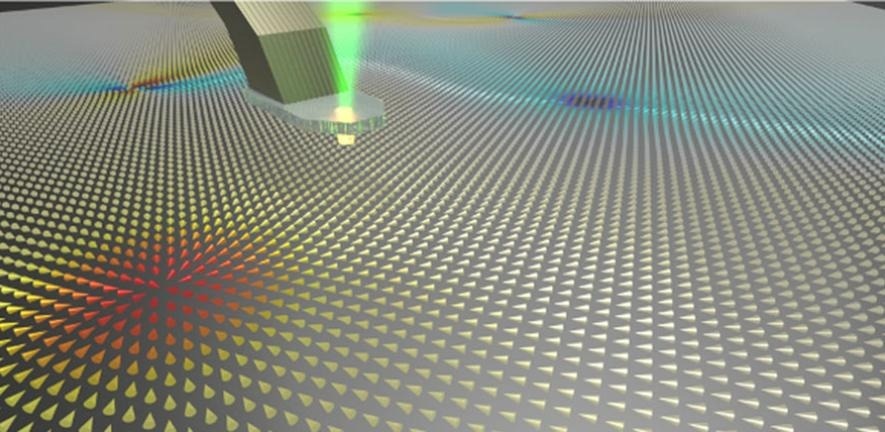Scientists have detected magnetic monopoles—individual magnetic charges—in a substance closely associated with rust, suggesting potential applications for advancing eco-friendly and faster computing technologies.
 Magnetic monopoles in hematite. Image Credit: Anthony Tan and Michael Hoegen
Magnetic monopoles in hematite. Image Credit: Anthony Tan and Michael Hoegen
Utilizing diamond quantum sensing, a team led by the University of Cambridge observed subtle magnetic signals and swirling patterns on the hematite surface, an iron oxide.
The researchers noted that the emergence of magnetic monopoles in hematite is a result of the collective behavior of numerous spins (particle angular momentum), resembling miniature magnetic charge hockey pucks gliding across the swirling textures.
This marks the first experimental observation of naturally occurring emergent monopoles. The study also unveiled a direct link between previously concealed swirling patterns and the magnetic charges of materials like hematite, akin to an encoded connection.
Published in the journal Nature Materials, these findings may contribute to the development of next-generation logic and memory applications. Contrary to James Clerk Maxwell's equations, which dictate that magnetic objects exist as pairs of poles, these discoveries challenge the conventional understanding of magnetic behavior.
The magnets we use every day have two poles: north and south. In the 19th century, it was hypothesized that monopoles could exist. But in one of his foundational equations for the study of electromagnetism, James Clerk Maxwell disagreed.
Mete Atatüre, Study Lead Researcher and Professor, University of Cambridge
Atatüre is Head of Cambridge’s Cavendish Laboratory, a position once held by Maxwell himself.
Atatüre adds, “If monopoles did exist, and we were able to isolate them, it would be like finding a missing puzzle piece that was assumed to be lost,”
Approximately 15 years ago, scientists proposed the potential existence of monopoles within a magnetic material. This theoretical concept hinged on the notion of extreme separation between the north and south poles, creating a scenario where each pole seemed isolated in a unique substance known as spin ice.
However, an alternative approach to identifying monopoles involves the principle of emergence. This idea suggests that the combination of numerous physical entities can generate properties that surpass or differ from the sum of their individual parts.
Collaborating with counterparts from the University of Oxford and the National University of Singapore, researchers from the University of Cambridge utilized the concept of emergence to reveal monopoles distributed across two-dimensional space, traversing the swirling patterns on the surface of a magnetic material.
These intricate topological textures manifest in two primary categories of materials: ferromagnets and antiferromagnets. Among these, antiferromagnets exhibit greater stability than ferromagnets, albeit proving more challenging to study due to their less pronounced magnetic signatures.
To investigate the behavior of antiferromagnets, Atatüre and the team employed a diamond quantum magnetometry imaging technique. This method leverages a single spin, the inherent angular momentum of an electron within a diamond needle, to measure the magnetic field on a material's surface precisely without influencing its behavior.
In the current research, the scientists applied this technique to examine hematite, an antiferromagnetic iron oxide material. To their astonishment, they uncovered concealed patterns of magnetic charges within hematite, including monopoles, dipoles, and quadrupoles.
Monopoles had been predicted theoretically, but this is the first time we’ve actually seen a two-dimensional monopole in a naturally occurring magnet.
Paolo Radaelli, Study Co-Author and Professor, University of Oxford
These monopoles are a collective state of many spins that twirl around a singularity rather than a single fixed particle, so they emerge through many-body interactions. The result is a tiny, localized stable particle with diverging magnetic field coming out of it.
Dr. Hariom Jani, Study Co-First Author, University of Oxford
“We’ve shown how diamond quantum magnetometry could be used to unravel the mysterious behavior of magnetism in two-dimensional quantum materials, which could open up new fields of study in this area,” said co-first author Dr. Anthony Tan from the Cavendish Laboratory.
Tan added, “The challenge has always been direct imaging of these textures in antiferromagnets due to their weaker magnetic pull, but now we’re able to do so, with a nice combination of diamonds and rust.”
The research not only emphasizes the capabilities of diamond quantum magnetometry but also underscores its potential to reveal and explore concealed magnetic phenomena within quantum materials. If harnessed, these magnetic charges adorned in swirling textures could drive ultra-fast and energy-efficient computer memory logic.
Funding for the study was provided, in part, by the Royal Society, the Sir Henry Royce Institute, the European Union, and the Engineering and Physical Sciences Research Council (EPSRC), a component of UK Research and Innovation (UKRI).
Journal Reference:
Tan, A. K. C., et al. (2023) Revealing emergent magnetic charge in an antiferromagnet with diamond quantum magnetometry. Nature Materials. doi.org/10.1038/s41563-023-01737-4.